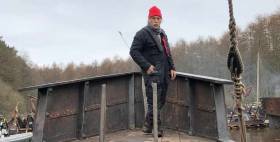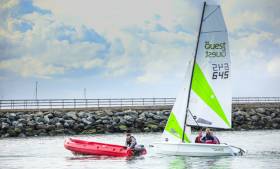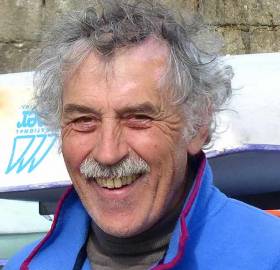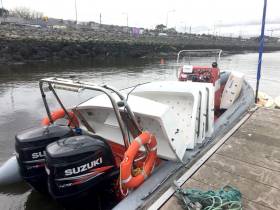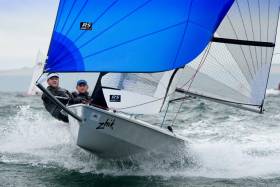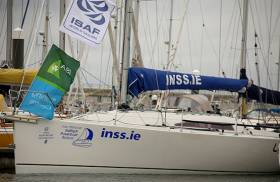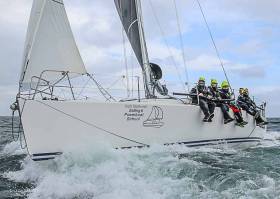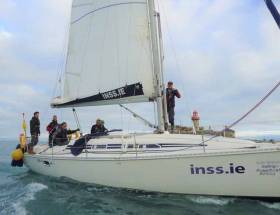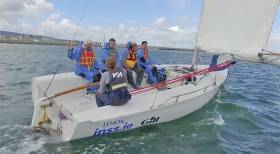Displaying items by tag: INSS
From Beginner Sailors to Viking Oarsmen – Alistair Rumball Relives 40 years of Teaching Sailing Next Wednesday
Forty years ago, when Alistair Rumball started the Irish National Sailing & Powerboat School the fleet comprised of four Darragh 14 sailing dinghies, one 21ft Sherrif Day Sailor and a 15ft O’Sullivan “Crash Boat” with a 9.9hp engine.
The school was based on Dun Laoghaire's Lower George’s street in a small building and had a small yard out the back, large enough to fit one or two of the fleet into it at a time. A look back at those early days is contained in WM Nixon's profile of Alistair here.
Fast forward 40 years, and the small introductory programmes have expanded to include a busy marine services division for film and television, with titles such as “Saving Private Ryan”, “Robin Hood”, “PS I Love You” and “The Guard” part of the show reel.
The largest, and currently on-going project, is the TV series “Vikings” filmed in Ireland at locations including Lugala, Loch Dan and off Wicklow head. Alistair head’s the Irish National Sailing & Powerboat School’s Marine Services Division which, not only provides marine co-ordination for up to 200 cast and crew on the water, but also organises all the logistics of getting countless craft, including 50ft Viking Ships, onto location.
Check out a few of the videos for a flavour of this work…
Delivery of Viking Longboat to Wood Quay (during Friday evening rush hour)
Launching a Fleet in the Wicklow Mountains!
Viking Battle in Dun Laoghaire Harbour
Test Sailing a Small Longboat
As Afloat.ie previously reported, Alistair will be reliving 40 years of teaching, both students and Vikings, on Wednesday the 18th of April at 8pm at the INSS Clubhouse on the West Pier in Dun Laoghaire. The talk is titled “A Life in the Irish National Sailing School”. All are very welcome to attend.
RS Quest Training Dinghy Makes Dun Laoghaire Debut at INSS
The new RS Quest family and training dinghy has made its Dun Laoghaire debut, thanks to its new RS Irish agents based at the east coast port.
RS agent Kenneth Rumball of the Irish National Sailing and Powerboat School was appointed last month to the new sales role.
The INSS used the boat recently for RYA and ISA instructor training courses, leading school founder Alistair Rumball to declare the new marque 'very versatile'. Top marks indeed!
The RS Quest is a modern family or training dinghy with features that move the game forward. Big enough for an instructor and 2 or 3 pupils – perfect for Mum or Dad and youngsters – small enough to handle easily ashore and afloat. Inspired by the UK Sea Cadets to replace their aging fleet, the RS Quest has rapidly become the best-selling dinghy of its type worldwide.
Durable rotomoulded polyethylene construction – space and stability – reefing, spinnaker, stowage and a host of other options. It’s not easy to make it all work but our development team have nailed it on this boat. With options of Symmetrical or Asymmetrical Spinnaker use there really are all the options available.
"We have chosen the Quest due to its huge versatility. From getting children afloat for the first time to advanced adult teaching, there now is one boat that can do it all", according to Kenny Rumball.
More on the RS Quest here
The Irish National Sailing & Powerboat School at Dun Laoghaire is celebrating it’s 40th birthday this year, having been established by Alistair Rumball in 1978. From very humble beginnings above a charity shop on George’s Street in Dun Laoghaire, the school has grown to be one of the largest water sports centres on the British Isles. Now the school is looking to get back in touch with all the staff and course graduates who’ve been through their doors!
On Wednesday the 18th of April at 8pm, school founder and centre principal Alistair Rumball will deliver a talk titled “A life in the Irish National Sailing School”. Reflections on 40 years of teaching, the highlights and plenty of entertaining tales all are on the agenda.
Alistair will also share his views on the future of sailing, both in Dun Laoghaire and more generally. All are invited to attend.
"School founder Alistair Rumball will deliver a talk titled “A life in the Irish National Sailing School”
Then on Saturday the 12th of May the school will host an open day where past staff and graduates are invited to return to get as many of the 250–boat fleet on the water at one time, followed by a small celebration back ashore.
Alistair is looking to see as many old faces, and new ones, as possible on both Wednesday 18th and Saturday 12th May. Let the school know if you're coming along by contacting the school’s office on 01 284195 or [email protected].
Even if you’re not able to make either event, Alistair’s still looking to hear from you and see where your sailing skills or instructing qualification has taken you.
The Irish National Sailing School and Powerboat School are assisting Poolbeg Yacht and Boat Club (PYBC) in Dublin city centre with Easter Sailing Courses.
PYBC will offer Easter Sailing and Watersports Courses for children aged 7-17 years.The the success of our programmes is 'rooted in the dynamic of dividing children into groups of their own age', Rumball told Afloat.ie
Headquartered in Dun Laoghaire Harbour, INSS also has a base in Malahide in North Dublin.
RS Sailing has appointed two new dealers in Ireland following the retirement of Belfast–based McCready Sailboats. The Irish National Sailing and Powerboat School has been appointed in Dublin with a new chandlery appointment in Northern Ireland too.
New RS agent Kenneth Rumball of the Irish National Sailing and Powerboat School is one of Ireland's top sailors with success in the Optimist, 420, Fireball and offshore. Rumball brings a wealth of racing and sailing knowledge to the team. Together with Brian Spence (formerly of McCready) Bosun Bobs Chandlery will represent the brand in NI.
The RS400, 200 and Feva classes are widely sailed across Ireland.
This is an exciting year for RS Sailing who celebrate 25 years racing with one of the world’s biggest ever dinghy events when the RS Games kicks off at Weymouth in August. The anniversary year will also see the launch of three new boats.
New for 2018
RS Zest - Brand new compact boat that replaces the RS Quba and delivers more crew space and practical, enjoyable features than older generation rivals.
RS CAT14 - This boat takes the enjoyment and handling associated with beach cats to a new level.
RS21 - Progressive keelboat solution for club programs and sailor teams. The RS21 is specially designed for fleet purchase, with attributes that will appeal to individual buyers as well.
Brush Up On Dinghy Racing Tactics & Strategy With The INSS
#INSS - The Irish National Sailing and Powerboat School (INSS) will host the first of its three-date series on dinghy racing tactics and strategy on Tuesday 3 April.
Multiple dinghy national champion and offshore helmsman Kenneth Rumball is holding this series of evening discussions to help dinghy sailors improve their race skills and awareness.
These evenings are specifically designed for dinghy sailors and will encourage attendees to ask specific questions on scenarios they have been in, and discuss the best solutions.
The three sessions will take place on Tuesday 3, Thursday 5 and Tuesday 10 April. Admission for all three, including complementary tea/coffee and course notes each evening, is €20.
INSS Offers Discount For Last Places On Next Week’s Competent Crew Course
#INSS - Owing to a late cancellation, the Irish National Sailing & Powerboat School is overing a discounted rate for two remaining places on its Competent Crew course setting sail next Monday 19 February.
Normally priced at €699, the last two spots are available for only €499 for the five-fay course along the East Coast, paired with the parallel Coastal Skipper Course.
More details on the course can be found HERE, including how to book. But act fast as they won’t be available for long!
Irish National Sailing School Introduce Cruiser Racer Training Programme
Go–ahead sailing school, the Irish National Sailing School based in Dun Laoghaire Harbour, that has already opened a new base in Malahide for 2018, announced this week it will stage a new cruiser–racer training programme designed to bridge the gap between introductory sailing courses and competence to a basic level on aboard a cruiser-racer racing predominately inshore.
The course will run on Sunday 8th April and Sunday 15th April (10am-5pm each day). The programme fees are €249.
The comprehensive tweo day course will cover Sailing racing terms and definitions, Layout of a racing boat, General racing etiquette, Rigging of a racing boat, Safe use of winches, Safe use and operation of clutches and cleats on a racing boat and procedures for basic manoeuvres such as tacking, gybing, spinnaker hoists and spinnaker drops.
This course will be held on an appropriate racing boat based in Dublin Bay. The course will be primarily practical with some small areas covered on the boat in a theory style basis.
Basic racing rules, outline sailing instructions and racing courses, the importance of communication and crew safety topics are also covered.
More details and to book click here
Irish National Sailing & Powerboat School to Run Yachting Courses from Malahide in 2018
The Irish National Sailing & Powerboat School will run a series of yachting programmes on a trial basis from Malahide in County Dublin this year. The schedule will include the introductory RYA Start Yachting Course, the 5-day RYA Competent Crew Course and the RYA Day Skipper, for aspiring skippers. Course will run from Malahide Marina, where we are also running a schedule of Irish Sailing Powerboat Programmes.
The expansion from Dun Laoghaire has been facilitated by the recent addition of the Elan 36, Dreamcatcher to the yacht training fleet and builds upon a significant increase in demand for this type of training.
Speaking about the new Malahide base, Alistair Rumball, originally from the area, having started his sailing on the estuary says “It’s a lifetime’s ambition realised. In my teaching opinion, Broad Meadows, the Estuary and the coastal area are most wonderful sailing areas and I’m delighted to be back!”
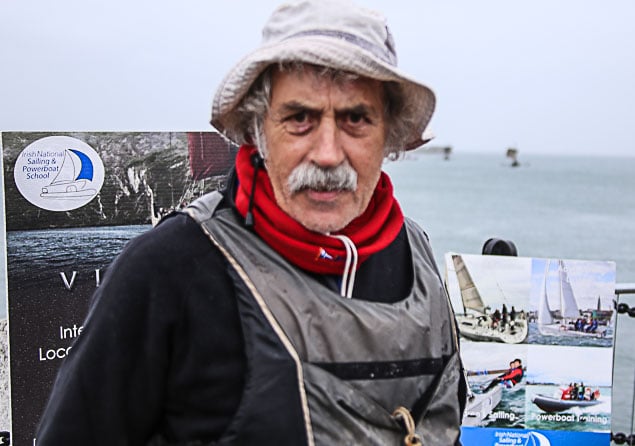 Alistair Rumball of the INSS is back in Malahide Photo: Afloat.ie
Alistair Rumball of the INSS is back in Malahide Photo: Afloat.ie
INSS Malahide Sailing Course Information:
- Start Yachting Course
- Competent Crew Course
- Day Skipper Course
- Powerboat Courses
The Irish National Sailing & Powerboat School is Ireland’s largest sailing and powerboat training provider and has operated out of Dun Laoghaire Harbour for 40 years. RYA Cruising Courses, including Start Yachting, Competent Crew, Day Skipper, Coastal Skipper and Yachtmaster are conducted on board the school fleet of training yachts.
In addition to this training, the school runs a busy programme of adult introductory dinghy, yacht and powerboat courses, as well as children’s sailing course throughout school holidays and at weekends during the school year.
For more information: Irish National Sailing & Powerboat School Glyn Williams Ph: 01 2844195 [email protected]
INSS Looks Back Over Action-Packed 2017 Ahead Of 40th Anniversary
#INSS - The Irish National Sailing & Powerboat School has posted a video looking back at what was a busy 2017 on the water in Dun Laoghaire.
Highlights of the last 12 months include over 2,500 children sailing on the INSS’s summer courses, as well as more than 800 adults taking part in the increasingly popular yacht and dinghy programmes.
Another highlight, as previously reported on Afloat.ie, was the stellar performance of the school’s J109 Jedi in last August’s Rolex Fastnet Race.
The INSS hopes to welcome even more budding sailors, young and old, to join its training fleet in its 41st year.


























